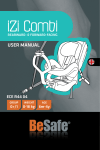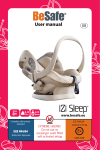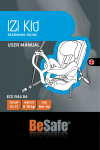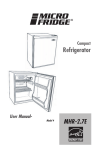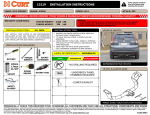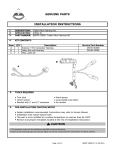Download User manual for BeSafe iZi Combi X4 ISOfix-GB
Transcript
26 1 34 27 35 16 2 4 3 5 USER MANUAL 6 7 8 28 29 12 9 13 10 11 14 15 36 31 17 19 Rearward- & forward-facing 20 21 23 Group 0+ - 1 18 Weight 0-18 kg Age 6m - 4y 37 30 ECE R44 04 24 38 22 25 32 33 39 40 47 41 49 52 54 Thank you for choosing BeSafe iZi Combi ISOfix 60 BeSafe has developed this seat with great care, to protect your child during the first phase of his or her life. D C •The harness straps must always be locked when the child is in the seat. •The harness straps must be tightened without slack and not twisted. •The seat cover contains magnets in the areas with the orange indications. Magnets can influence electronic equipment such as pacemakers. •The floor support must always be used when it is installed rearfacing. Make sure that the floor support is fully pushed down. When installing forward-facing the floor support and the front brace shall not be used. •When installed with ISOfix: Make sure the indicators are green before you drive. •We recommend to use the seat as long as possible in the rearfacing installation. •We recommend that this seat is used only for children who can sit upright, so not younger than 6 months. •For children under 1 year and/or under 10 kg weight, we recommend that the most reclined sitting position and the body hugger and baby cushion (extra available accessory) are used. •Remove the baby cushion (extra available accessory) when the child is older than 1 year. •Remove the body hugger when the child is older than 2 years. •When the child weighs over 18 kg or the shoulder height grows above the highest position of the shoulder straps, the child must change to a seat, suitable for children with a weight above 18 kg. •After an accident, the seat must be replaced. Although it may look undamaged, if you were to have another accident, the seat may not be able to protect your child as well as it should. •Prevent the seat from becoming trapped or weighed down by luggage, seats and/or slamming doors. •Before every use, make sure the harness is not damaged or twisted. B 53 !! It is important that you read this user manual BEFORE installing your seat. Incorrect installation could endanger your child. A 55 42 43 Contents 56 44 Vital information Preparing to install Rearfacing ISOfix installation Forward-facing belt installation Positioning the child Sleeping position Removing and refitting the cover Cleaning instructions Warning: potential misuse Important advice Guarantee Point of sale information 48 50 57 45 58 61 62 46 63 59 51 10 12 13 16 18 18 19 19 20 20 22 23 !! Vital information •It is NOT ALLOWED to mount the seat in a front passenger seat WITH AN ACTIVATED AIRBAG. •iZi Combi ISOfix can be installed rearfacing with the ISOfix anchorage in a car equipped with ISOfix anchorage points. •iZi Combi ISOfix can be installed forward-facing with a 3-point car belt, approved to UN/ECE Regulation No. 16 or other equivalent standards. •iZi Combi ISOfix is approved in groups 0+ and 1, rearfacing from 0-18 kg and group 1, forward-facing from 9-18 kg. •Read the car list to find out whether your car model is approved to use the seat. 10 11 Rearward-facing: ISOfix installation •Make sure you can fit no more than one finger between the harness and your baby (1 cm). •If in doubt, consult either the car seat manufacturer or the retailer. Preparing to install Crucial parts 1.Adjustable head rest 2.Shoulder straps (2x) 3.Harness buckle 4.Body hugger 5.Front brace 6.Central adjuster 7.Reclining lever 8.Belt guiding hook 9.Ratchet for front brace 10.Cap ISOfix connector (2x) 11.Switch for ISOfix connectors (2x) 12.Wedge 13.Floor support 14.Height adjuster floor support 15.Floor support height indicator 16.Belt clamp (2x) 17.Release handle head rest 18.Floor support position indicator 19.ISOfix car anchorage (2x) 20.ISOfix insertion clips (2x) (bottom side) 21.ISOfix connectors (2x) 22.ISOfix indicators (2x) 23.ISOfix release button (2x) 12 !! It is NOT ALLOWED to mount the seat in a front passenger seat WITH AN ACTIVATED AIRBAG. 1.The seat can only be installed rearfacing in vehicles equipped with ISOfix anchorage points. 2.Remove the wedge. (24) 3.When mounting in the back seat of the vehicle, push the front seat of the vehicle forward as much as possible. 4.When mounting in the front seat of the vehicle, adjust the back rest into an upright position. 5.Positioned in the front seat of the vehicle, you should position the seat against the dashboard. 6.If it’s not possible to position the seat against the dashboard, position the seat as far as possible from the dashboard. 7.Find the ISOfix anchorage points in the vehicle. (25) 8.If your vehicle is not equipped with ISOfix insertion clips insert these to make installation easier. (26) 9.You can find the ISOfix insertion clips under the base of the seat or delivered separately with the seat. 10.Install the front brace by sliding the two pins into the oval tube under the front side of the seat. Move the front brace inwards with the ratchet. The ratchet is used to adjust the front brace in both directions. Slide the switch on the ratchet up or down to change direction. (27) 11.Pull both ISOfix connectors as far out as possible, by pushing the grey buttons on top of the base. (28) 12.Remove the caps from the ISOfix connectors by pressing down the ISOfix release buttons. (29) 13.Click the installation clips on the ISOfix connectors. (30) 14.Fold down the floor support before you install the seat in your vehicle. (31) 15.Place the seat sideways into the car with the front brace towards you. 16.Turn the seat into the right position (with the front brace against the back rest). 13 Removing the seat 17.Click the ISOfix connectors in the ISOfix anchorage of the vehicle. (32) 18.Remove the installation clips. 19.Make sure that all indicators on both sides are green. (33) 20.Push the seat towards the backrest of vehicle seat till the frontbrace touches the backrest; the isofix arms slide in and will click into a new position. (34) 21.Move the front brace outwards with the ratchet. Continue tightening until the brace is pressed well into the back rest of the vehicle seat. (35) 22.Adjust the floor support so it is in contact with the floor of the vehicle. (36) 23.The height indicator of the floor support shows green when the floor support is in contact with the floor. (37) 24.Positioned in the back seat of the vehicle, you should, if possible, push the front seat of the vehicle backwards, so that it is in contact with the child seat. If it is not possible to obtain contact with the child seat, push the back rest of the front seat of the vehicle forward as far as possible. 25.When you want to enlarge the available space for your child, keep the isofix arms totally slided out without pushing the seat towards the backrest, and tension the frontbrace outwards with the rachet. 26.Make sure the floor support is fully pushed down, in contact with the floor of the vehicle, and locked. 27.Make sure that all indicators on both sides are green. 14 1.If the seat is installed in the back seat of the vehicle, push the front seat of the vehicle forward as much as possible. 2.Move the front brace inwards with the ratchet. (38) 3.Release the ISOfix connectors by pressing the release mechanism on the ISOfix connectors. (39) 4.Push the switch on each side and push the ISOfix connectors into the base. (40) 5.Pull the seat back towards the front. Turn the seat so you can easily remove the seat. 6.Remove the insertion clips from the vehicle. Place them under the base of the child seat. 7.To remove the front brace from the metal tube, move the front brace outwards with the rachet, until the lock button of the front brace appears. Push the lock button down with a small screw driver, while pulling the front brace out. (41) 15 Forward-facing belt installation 1.When mounting in the back seat of the vehicle, push the front seat of the vehicle forward as much as possible. 2.When mounting in the front seat of the vehicle, adjust the back rest in an upright position. 3.Install the wedge on the bottom of the seat; position the hooks in the hole. (42) Rotate the wedge until you hear click. (43, 44) 4.Install the seat in forward facing position without front brace and the floor support in folded up position. 5.Put the child seat on the seat of the vehicle. Unlock the belt clamps. (45) 6.Release the release handle at the back of the head rest and push the head rest down while keeping the head rest upright. (46) 7.Pull the hip belt around the bottom base of the seat and click the car belt in the buckle. (47) 8.Position the hip belt over the belt guiding hook. (48) 9.Put the shoulder belt through the belt clamps. Make sure the belt is not twisted. (49) 10.Push the seat firmly into the car seat. 11.Tight installation is most important for forward facing seats. Tension the belts as follows (49): Pull the shoulder belt upwards (A). Have a firm grip on the shoulder belt in the seat area B. Close the clamp on the inner side C. Pull upper belt part on the door side and close clamp D. (50) 12.Adjust the belt guiding hook outwards with the ratchet. Continue tightening until the seat is pressed well into the back rest of the car seat. Push the head rest in the correct position (refer to ‘Positioning of the child’ on 18). The seat is now ready to use. (51) 16 Removing the seat 1.Loosen the tension in the car belt by moving the belt guiding hook inwards with the ratchet. 2.If the seat is installed in the back seat of the vehicle, push the front seat of the vehicle forward as much as possible. 3.Unlock the belt clamps and unlock the car belt. 4.Remove the car belt and remove the seat from the vehicle. 17 Positioning the child 1.Position of the shoulder straps: Check that the shoulder strap slots are level with your child’s shoulders. •too high (52) •correct (53) 2.The height of the shoulder straps and the head rest can be adjusted by pulling the release handle upwards at the back of the head rest and pulling the head rest up or down while keeping the head rest upright. (54) 3.Pull the shoulder straps up while pressing the button of the central adjuster. (55) 4.Open the harness buckle. 5.Position the shoulder straps over the orange marking at sides of the seat to keep the harness open while you position the child. (56) 6.When the child is positioned, place the shoulder straps over the child’s shoulders and close the buckle: CLICK! (57) 7.Pull the harness strap through the central adjuster in the direction of the arrow straight up/forwards. Continue pulling until the harness is a comfortable but firm fit. (58) !! Make sure that the harness straps are always locked and tightened when the child is in the seat. Removing and refitting the cover Removing the cover •Do take care when you remove the cover, as fitting the cover is done in reverse. •Start taking off the lower seat part. (60) •The cover of the head rest can be taken off separately by disconnecting the hooks at the back and pulling off the fabric towards the front. Refit the cover •Pull the head rest in the highest position. Replace the head rest cover and reconnect the hooks at the back side. Pull the harness straps through the holes. Connect the loose lower part of the head rest fabric with the plastic part below the head rest. •Refit the top part and then the shoulder parts. Refit the seat part and bring the seat cover under the rear parts of the sidewalls. Cleaning instructions •The cover of the seat must be washed according to the instructions on the inside of the cover. •DO NOT use any aggressive cleaning products; these may harm the construction material of the seat. Sleeping position •The seat has 3 positions. •By pulling the recline lever upwards, the seat can be adjusted into another position. (59) 18 19 !! Warning: potential misuse Rearfacing •It is NOT ALLOWED to mount the seat in a front passenger seat WITH AN ACTIVATED AIRBAG. •DO NOT use the seat without floor support. •DO NOT use the seat without tightening the front brace. •Make sure the indicators are green before you drive. Forward-facing •DO NOT install the seat forward facing without using the wedge. •Install only with 3-point car belts, approved to UN/ECE Regulation No. 16 or other equivalent standards. (61) (shoulder belt (62), hip belt (63)) !! Important advice •DO NOT attempt to dismantle, modify or add any part to the seat. Warranty will be void if non-original parts or accessories are used. •DO NOT use anything, such as a cushion, to raise the child seat off the passenger seat of the vehicle. In an accident the seat will not be able to protect your child in the right way. •Never leave your child unattended in the seat. •Make sure all passengers are informed about how to release your child in case of emergency. •An empty child seat should always be fastened in the vehicle. •Make sure luggage or other objects are properly secured. Unsecured luggage may cause severe injuries to children and adults in case of accidents. •Never use the seat without the cover. The cover is a safety feature and may only be replaced by an original BeSafe cover. 20 •Under the cover we use EPS foam. Do not push or pull too hard against the foam, as you may damage the foam. •Do not use any aggressive cleaning products; these may harm the construction material of the seat. •BeSafe advises that child seats should not be bought or sold second-hand. •KEEP this user manual for later use with the seat. •DO NOT use at home. It has not been designed for home use and can only be used in a vehicle. •When installed with ISOfix: Check the manufacturer’s vehicle handbook. Practical advice When the child seat is mounted in the car check all the areas where the child seat might touch the interior. We recommend using a (BeSafe) protection cover in these places to avoid cuts, marks or discolouration on the interior of the vehicle, especially in vehicles with leather or wooden interior. 21 Guarantee •All BeSafe products are carefully designed, manufactured and tested. All of our BeSafe child seats are tested periodically out of our continuous production in our test laboratory. Furthermore they are tested by independent test institutes. •Should this product prove faulty within 24 months of purchase due to materials or manufacturing fault, except covers and harness straps, please return it to the original place of purchase. •The guarantee is only valid when you use your seat appropriately and with care. Please contact your retailer, they will decide if the seat will be returned to the manufacturer for repair. Replacement or return cannot be claimed. The guarantee does not get extended through repair. •The guarantee expires: when there is no receipt, when defects are caused by incorrect and improper use, when defects are caused by abuse, misuse or negligence. Point of sale information Notice for REARFACING installation •This is a semi-universal ISOfix Child Restraint System. It is approved to regulation No. 44.04, series of amendments for general use in vehicles fitted with ISOfix anchorage systems. •It will fit cars with positions approved as ISOfix positions (as detailed in the vehicle handbook), depending on category of the child seat and of the fixture. •The mass group and the ISOfix size class for which this device is intended is: C. •The seat is suitable for fixing into the seat positions of the vehicles listed in the separate ‘car list’. Seat positions in other vehicles may also be suitable to accept this child restraint. If in doubt, consult either the child restraint manufacturer or the retailer. For updated car list see: www.besafe.com. Notice for FORWARD FACING installation •When installed with a 3-point car belt: Only suitable if the approved vehicles are fitted with 3-point car belts, approved to UN/ECE Regulation No. 16 or other equivalent standards. •We recommend to use the seat as long as possible in the rearfacing installation. Next car seat •When the child has grown out of the seat, BeSafe recommends to use the next seat for children above 18 kg. up to a height of at least 135 cm. 22 23 B1301-8013 N2002500












